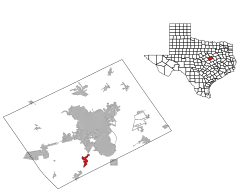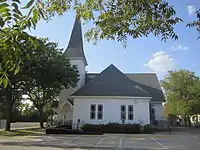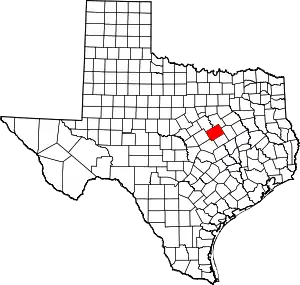Lorena, Texas
Lorena is a small city in McLennan County, Texas, United States. The population was 1,785 at the 2020 census. It is part of the Waco Metropolitan Statistical Area.
Lorena, Texas | |
|---|---|
.jpg.webp) Downtown Lorena | |
 Location within McLennan County | |
 Lorena Location within Texas  Lorena Location within the United States | |
| Coordinates: 31°22′57″N 97°12′47″W | |
| Country | United States |
| State | Texas |
| County | McLennan |
| Settled | 1854 |
| Government | |
| • Type | Council–manager government |
| Area | |
| • Total | 3.40 sq mi (8.80 km2) |
| • Land | 3.40 sq mi (8.80 km2) |
| • Water | 0.00 sq mi (0.00 km2) |
| Elevation | 604 ft (184 m) |
| Population (2020) | |
| • Total | 1,785 |
| • Density | 516.63/sq mi (199.46/km2) |
| Time zone | UTC-6 (Central (CST)) |
| • Summer (DST) | UTC-5 (CDT) |
| ZIP code | 76655 |
| Area code | 254 |
| FIPS code | 48-44020[3] |
| GNIS feature ID | 1361796[4] |
| Website | www |

.JPG.webp)


Geography
Lorena is located at 31°22′57″N 97°12′47″W(31.382482, –97.212998).[5]
According to the United States Census Bureau, the city has a total area of 3.2 square miles (8.3 km2), all land. Lorena is off Interstate 35 and where Highway 81 originally was located.
Demographics
| Census | Pop. | Note | %± |
|---|---|---|---|
| 1970 | 406 | — | |
| 1980 | 619 | 52.5% | |
| 1990 | 1,158 | 87.1% | |
| 2000 | 1,433 | 23.7% | |
| 2010 | 1,691 | 18.0% | |
| 2020 | 1,785 | 5.6% | |
| U.S. Decennial Census[6] | |||
| Race | Number | Percentage |
|---|---|---|
| White (NH) | 1,428 | 80.0% |
| Black or African American (NH) | 18 | 1.01% |
| Native American or Alaska Native (NH) | 10 | 0.56% |
| Asian (NH) | 14 | 0.78% |
| Some Other Race (NH) | 16 | 0.9% |
| Mixed/Multi-Racial (NH) | 63 | 3.53% |
| Hispanic or Latino | 236 | 13.22% |
| Total | 1,785 |
As of the 2020 United States census, there were 1,785 people, 644 households, and 514 families residing in the city.
As of the census[3] of 2000, 1,433 people, 537 households, and 417 families resided in the city. The population density was 444.8 inhabitants per square mile (171.7/km2). There were 551 housing units at an average density of 171.0 per square mile (66.0/km2). The racial makeup of the city was 94.21% White, 0.98% African American, 0.14% Native American, 0.91% Asian, 3.07% from other races, and 0.70% from two or more races. Hispanics or Latinos of any race were 5.86% of the population.
Of the 537 households, 39.1% had children under the age of 18 living with them, 63.5% were married couples living together, 11.9% had a female householder with no husband present, and 22.3% were not families. About 21.2% of all households were made up of individuals, and 10.1% had someone living alone who was 65 years of age or older. The average household size was 2.67 and the average family size was 3.10.
In the city, the population was distributed as 28.5% under the age of 18, 6.6% from 18 to 24, 29.9% from 25 to 44, 22.6% from 45 to 64, and 12.5% who were 65 years of age or older. The median age was 37 years. For every 100 females, there were 90.8 males. For every 100 females age 18 and over, there were 84.0 males.
The median income for a household in the city was $47,891, and for a family was $54,083. Males had a median income of $37,560 versus $27,647 for females. The per capita income for the city was $19,315. About 3.1% of families and 5.0% of the population were below the poverty line, including 4.4% of those under age 18 and 11.3% of those age 65 or over.
Education
The City of Lorena is served by the Lorena Independent School District.It is home to the Lorena Leopards.
History
Lorena is named after one of the town's first settlers' oldest daughter, Lorena Westbrook, although its original name was "Aerl Station" after the town's founder, Daniel Aerl.[10]
Notable person
- Holly Tucker, singer[11]
References
- "City Council | Lorena, TX - Official Website". Lorena, TX. Retrieved August 9, 2020.
- "2019 U.S. Gazetteer Files". United States Census Bureau. Retrieved August 7, 2020.
- "U.S. Census website". United States Census Bureau. Retrieved January 31, 2008.
- "US Board on Geographic Names". United States Geological Survey. October 25, 2007. Retrieved January 31, 2008.
- "US Gazetteer files: 2010, 2000, and 1990". United States Census Bureau. February 12, 2011. Retrieved April 23, 2011.
- "Census of Population and Housing". Census.gov. Retrieved June 4, 2015.
- "Explore Census Data". data.census.gov. Retrieved May 24, 2022.
- https://www.census.gov/
- "About the Hispanic Population and its Origin". www.census.gov. Retrieved May 18, 2022.
- "Ann Richards, 1988 Democratic National Convention Keynote Address, Atlanta, Georgia, July 19, 1988". americanrhetoric.com. Retrieved August 24, 2011.
- "Holly Tucker: Star still rising for Lorena girl after 'Voice' spotlight". wacotrib.com. Retrieved August 16, 2016.
